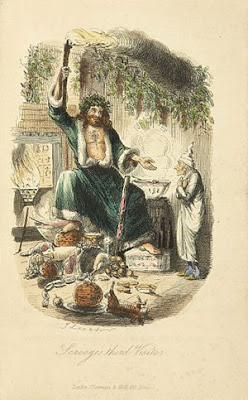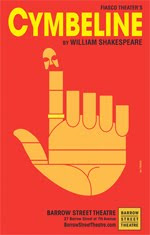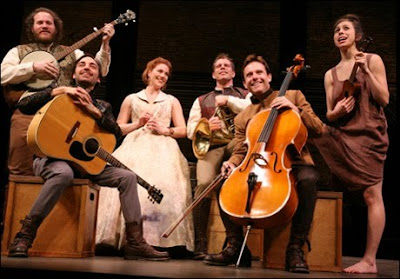
Friday, September 30, 2011

Wednesday, September 28, 2011
Coming soon. . .
Monday, September 26, 2011
Thursday, September 22, 2011
Tuesday, September 20, 2011
Saturday, September 17, 2011
Coming Soon. . .

In preparation for our upcoming production of A Child's Christmas in Wales, we begin here a series of snippets from the life and work of Dylan Thomas. Born in Swansea, Wales, Thomas famously died of alcohol poisoning at the Hotel Chelsea after a night of drinking at the White Horse Inn in Greenwich Village. The poetry he created remains among the best-loved, of the most-quoted poetry in the world. Watch our blog for excerpts from his work, snapshots of his life. See our first post, an excerpt from Fern Hill, above.
Thursday, September 15, 2011
Monday, September 12, 2011



If you're visiting us, you are a fan of great productions of Shakespeare's plays. Be sure to check out the Fiasco Company's production of Cymbeline now playing at the Barrow Street Theater, 27 Barrow Street, in Greenwich Village. Our review follows below.

The Original Fantastics
Fiasco Presents Cymbeline at the Barrow Street Theater
At the start of the Second Act of the Fiasco’s production of Cymbeline, now playing at the Barrow Street Theater in Greenwich Village, three characters break into a full-out Bluegrass number, replete with banjo, guitar and washboard. The song, like all the great Shakespeare songs, reminds us where we are in the play, examines characters’ dilemmas, and moves the plot along. My friend turned to me as it finished and enthused, “Now that’s the way to start Act II!”
Anyone who’s ever directed a play knows that the attack in Act II, the moment when you welcome the audience back into the world of the play is critical. This brilliant start of a brilliant Act II perfectly encapsulated the production’s strength: it is simply captivating.
Cymbeline is a difficult play to take seriously. A Monty Python-esque pastiche of Shakespeare’s best and worst moments, with characters, scenes and lines recognizable (yet no one’s sure if Cymbeline was written before or after any of them) from Othello, Macbeth, Romeo and Juliet, Julius Cesar, King Lear, A Winter’s Tale, Hamlet, Much Ado About Nothing, Twelfth Night and even Piramus and Thisby, the play within Midsummer Night’s Dream, the work is seriously over-written and crowded with ridiculous plot twists and moments of absurdity that owe their souls to Commedia del’Arte.
Thus may poor fools
Believe false teachers: though those that are betray'd
Do feel the treason sharply, yet the traitor
Stands in worse case of woe.
She finds the beheaded body of the man who by all appearances must be the lover who spurned her, and she is moved to pity him even while she scolds him. “O Posthumus! Alas, Where is thy head? Where’s that? . . This was my lord. . . . A very valiant Briton and a good.”
Pictured above: The cast of Fiasco's Cymbeline: Jessie Austrian(Imogen); Noah Brody(Co-Director/Posthumus/Roman Captain; Paul L. Coffey(Pisanio/Philario/Lucius/Guiderius); Andy Grotelueschen(Cymbeline/Cloten/Cornelius); Ben Steinfeld(Iachimo/Aviragus); Emily Young(Queen/Frenchman/Belaria). Photo courtesy of NYTimes.com.
Friday, September 9, 2011

http://www.youtube.com/user/terryflaxton?blend=1&ob=5#p/u/0/WeSN78EIQlg
Early in 2004 I received a call from my then business partner, producer Alison Sterling of Ignition Films. We! had shot various HD projects together and she called to tell me that Martin White, Professor of Theatre at Bristol University, had been won over by our arguments that HD was the way to go with his forthcoming research project for the Arts and Humanities Research Board. He wanted to make a high definition DVD. Back then, the specs for HD DVD had only just been agreed, but I guessed the technology to achieve our goal would be just coming on stream if we shot in December 2004, leading to post-production through 2005 and output to DVD by autumn/winter 2005.
In the Wickham Theatre at the University of Bristol, Martin and his designer Jennie Norman have made a full-scale reconstruction of an indoor Jacobean playhouse, based on drawings by Inigo Jones. It would have been in an intimate indoor space like this that the first performances of plays such as Webster!s The Duchess of Malfi would have played – to an audience altogether more select than at the outdoor Globe Theatre.
Martin wanted a way to recapture, as authentically as possible, the playing conditions of the time. The theatre is lit entirely by candlelight, with both tallow and beeswax candles handmade by a specialist chandler in Yorkshire using 17th century techniques. The actors were dressed by Shakespeare!s Globe, where designer Jenny Tiramani works entirely with the materials and methods of the period, producing exquisite, authentic (right down to the underclothes) hand-sewn costumes in the vibrant silks that would have been seen on stage at the time. Experienced classical actors (ex-RSC and Globe) rehearsed for two weeks on a variety of scenes chosen to exemplify the low-tech lighting methods of the time.
Possible solutions
The question arose as to the best way of documenting this event. We had to film two days of performance under conditions as close to the original lighting as possible. We also had to devise a method of filming that would reflect the way actors of the period would have used the auditorium, playing to different parts of the house. Jacobean actors and playwrights were well practiced at delivering their political message (and their asides) to the different social strata, and the cost of the seats broadly defined where each social class could be found in the playhouse. Glance to the expensive seats and the actor can talk to the aristocracy. Look to the cheap seats they are talking to the poor. Our contemporary audience would have to experience this through the use of our cameras looking at the actors as they addressed us. We began to formulate a plan derived from the brief.
On a standard DVD we know we can switch angles by the touch of a button. Therefore, how many strata of society were to be represented? The answer came back: four. So we had a four-camera shoot on our hands. We decided to use only the standard lens – yes, we had zooms, but we theorised that the part of the lens that produced what the eye would see from the camera positions would give the best sense of being in the auditorium to the DVD user, who could then switch viewpoint freely. I have actually shot a series of DVDs of recitals for music buffs using multiangle DVDs, so this was familiar territory to me. I knew it had to be HD from the start because we had to have not only the sensitivity, but also the resolution to reproduce the wonderful costumes. I first came across HD years ago on a Philips test shoot when I was technical co-coordinator of Philips! Customer Day. The whole of Philips worldwide shut down for a day and I organized an 18-country, nine-language, 10-camera shoot coming out of Eindhoven with live feeds from the 18 countries – complete madness, but it worked. Along the way, Philips wanted to try their 1250 line system (which incidentally was pretty good), but in the end bandwidth limitations and lack of cameras floored us, so we went 625 line PAL instead.
Since 2000 I’d used Sony!s 900 and then the 750, as well as Panasonic!s Varicam. The Sonys were slower in terms of light, at around 300 ASA (1080 lines), with Panasonic!s 60fps camera around 800 ASA (720 lines). There isn!t really time here to go into which format has more resolution and which has more colour information, but given the massive compression that all HD images currently go through to get to tape, there!s not really much in it between the two formats.
The cognoscenti of the HD world know that only when we have uncompressed data do we have a chance for complete technical and artistic excellence. I have output both systems to 35mm film and at that point it!s only a question of taste about the ‘feel’ of the image. You could always go to the new Sony SR deck and gather at greater data rates and quality, or you could go over to the Viper or the Genesis or Dalsa, etc for filmstream quality images – but then budget becomes an issue.
Available light
We had around 32 candles in four chandeliers and another eight on the wall, but I knew candles alone would not do the job. Shooting with candles is fearsomely difficult – not that you can!t shove any amount of light in and use any amount of tricks, but getting the look right is the real issue. Here I applaud the BBC!s version of Persuasion lit by John Daly for getting it right. Other more recent pumped-up versions of the candle look are more pyrotechnic in feel.
I had managed successfully to shoot a scene in a small HD drama lit by one candle using the Panasonic Varicam. It was clear to me that if there was any way the actors could carry their own lights whenever possible, then this would act as a key for both them and others around them if I had the camera settings in exactly the right place. And I mean exactly. If I went too far down in exposure, the image would be irrecoverable once it had gone into post and through compression for the incoming HD DVD systems. It was a characteristic of Jacobean staging that naked flame in various forms would be brought in to illuminate the action – torches, candles and lanterns were regularly carried by the actors to enhance the dramatic feel of a scene.
At the same time, we had to be authentic, so that meant as little light as possible. Given the brief from Martin, I was keen to find an image that reflected as accurately as possible what the audience might have seen while in the theatre. But then, not everything back then would have been distinct to the naked eye – the audience was supposed to be staring through the gloom of candlelight at a sometimes dull, sometimes undefined, sometimes distant image, brought to life by the presence of the bodies moving around in space, accompanied by the sound they generated while moving. And of course, the spoken text was more important then than the visual image (people in the 17th Century talked of going to "hear a play!).
The vibrancy of the costumes would have been a key factor for the audience, as the deep velvets sucked up light, making darker images amid the overall wash of candlelight. There would also be occasional sparkles given off by jewellery – and sometimes fine thread and glittery elements were sown into the costumes. All of this helped the theatre audience to create an image of the actors that was far clearer than their eyes were actually registering.
The shoot
In a spirit of authenticity I considered merely making technical decisions about format and camera and letting the image be, but in the end mind won over heart and I hung nine white paper globes above the stage. These had black skirts to stop light spill on to the sides of the set and I ran 275W photofloods inside them at between 15 and 20 per cent. This produced the right colour temperature and just a little extra light to enable the camera to stop grabbing at the image and producing artefacts from the data passing through the colour matrix and other digital processes.
I used different elements of my "grid! to bring up key or backlight. In this light the human eye would have to squint to see something. During much of the shoot I and my gaffer, Colin Holloway, would look at each other and without words express a sort of, “Oh well, into the abyss we plunge”, as we took the minimal extra light down and down. You could almost hear the cameras groaning.
As we got into the shoot there were moments when, as everyone gathered around the four monitors and expressed delight in the images, someone would say, “why can!t we go without any additional light at all?” I had to explain that monitors do not tell the truth about HD currently and, because of compression issues, the processes we would go through in post would change what they were seeing, which meant I had to use my precise judgement about exposure and its consequences.
Exposure had to be set at just the right place – exactly – and this judgement was born out of my own experiences, not out of a sense of hope. The monitor is always an issue on a shoot – everyone thinks they know what to do with light without realizing the interlaced nature of the image they are looking at and the ramifications of its route into post.
Post production
We got through the shoot OK and post-production has begun. We made DV clones, digitized into Final Cut and later I shall make the relevant timelines and do a standard DVD to make sure the whole thing works before re-digitizing into Final Cut at HD levels on Ignition!s own kit. The budget allows us to go into Final Cut!s Varicam codec and, given that we are off into DVD territory next, the compression involved at that stage is certainly no worse than the degradation and introduction of artifacts that comes from DVD compression.
I take advice all the time from top professionals in all the relevant areas so that my DP mind is in tune with my ‘post’ mind. Also, all DPs out there should be aware of Geoff Boyle!s wonderful Cinematographers Mailing List, as real pros from all around the world who are using high definition regularly exchange their experience about the use of new formats – as well as old. In the end it!s all a balancing act – getting the right HD format and the right post route for the desired outcome and the target price. If anyone out there knows any different about the HD DVD route I’m taking, get in touch.
Panasonic actually came in to sponsor the project at the post stage and let us have various decks for free to digitize at different levels, so we were doubly glad we!d picked them. At one level high definition is a minefield, especially if you!re going to make a film print or a film for digital projection. The TV routes that downconvert to PAL or NTSC are now becoming familiar, as are the output to HD channels in the US and elsewhere. As soon as a new format hits the market every cameraperson has to know about it and profess knowledge, and in HD there are many potholes to fall into, so you!d better be convinced that the DoP you!re talking to knows what they!re doing. The DoP is your advisor, your capturer of the image, the arbitrator between art and technicalities, the technical negotiator with the format and the crew and, critically, the quality control person for your project all the way through post. Choose wisely.
At another level HD is just another format, so you shouldn’t be scared of going into it – after all, using it is the best way of learning.
HDV purchase
On principle I never own cameras, so that their purchase doesn!t run my professional life. However, I have just broken my own rule and bought the little Sony HDV (HVR-Z1E) camera. Ignition Films, with Alison Sterling producing again, is currently shooting an ITV programme on it – shoot HDV then downconvert to PAL with a possibility of returning to the rushes when TV has up-rezzed to some form of HD. Later in the year we!ll be shooting the feature Human Remains on HDV, so as another format arises to fill our minds with new data, we rise to the challenge. And with the specs for ultra high definition video having been agreed, we look forward with excitement – and sometimes disbelief – to the claims by the equipment manufacturers of what is coming our way in the next few years.
Thursday, September 8, 2011
Saturday, September 3, 2011
Food for Thought
From time to time we will be posting stories about minor controversies in the world of Classical Theater, and we invite you to weigh in with your opinion. Today's blog posting from America Public Media's Marketplace Radio show (10 March 2011) is the first in this series, and we hope it will inspire reactions from our readers.
As part of a respected educational institution, we thought it appropriate, at the start of the new school year, to raise the question "To Cliff or not to Cliff. . . " And, to go one further, are the Cliffs of the Cliffs a brave new venture or a travesty, another indication that our culture is deteriorating fast and furiously.
Click on the link in the article below, and give a listen. Then write to us.
We want to hear from you. . . .



